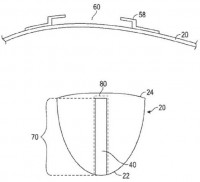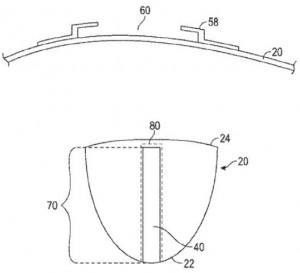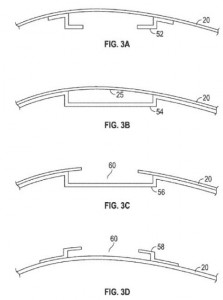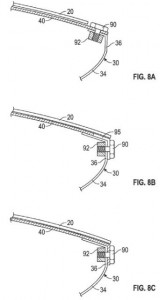A Callaway Golf Driver Design That Will Never Make It To The Market
Yes, as usual, if my prediction is wrong I will go out and buy one!
Interestingly, despite standing alone when it comes to promoting any meaningful advantage associated with CG height adjustability, Callaway seems to want to keep the driver design in question a secret. The patent application that resulted in the issuance of USPN 9022881 was filed with a nonpublication request seeking to keep the application confidential until the patent issued.
The patent is titled “CG Height Adjustability by Conformal Crown Weighting,” and describes the invention as:
A golf club head comprising a crown with an edge support structure and a flexible, conformal weight sized to fit within the edge support structure is disclosed herein. The edge support structure preferably is disposed on an internal surface of the crown so that the conformal weight is invisible when the golf club head is viewed at address. The conformal weight can be removed to adjust the vertical center of gravity of the club head, and preferably is oriented in a front-to-back direction along the club head’s X-axis. The conformal weight preferably is composed of a high-density polymeric material with a specific gravity ranging from 1.8 to 4.2.
Check out this design.
The patent goes on to explain:
Relatively little has been done with the placement of adjustable weights directly in the crowns of drivers. Positioning weights in a crown, especially near its highest point, is very effective in moving the vertical position of the center of gravity, and also is useful for controlling golf ball backspin, allowing the vertical component of golf ball trajectory to be optimized for different head speeds, swing styles and player preference. Unfortunately, achieving sufficient center of gravity range is difficult, such installations are visually distracting at address, the fixed structure of a weight port is inefficient and penalizes overall performance, and a concentrated mass located in the center of the crown can have an adverse effect on impact sound. Furthermore, impact sound may be noticeably different for different weighting configurations.
There are ways to deal with the appearance of a weight in the center of the crown. For instance, it is possible to cover the weight port with a medallion or cover piece. Unfortunately, this adds to the fixed portion of the adjustable weighting system mass and further detracts from its efficiency. The cover can also become a source of buzzing or can become detached and possibly lost. Mitigating such impact sound effects typically requires stiffeners, an increase in crown thickness, or both. Both of these approaches add to the fixed structural weight of the crown and tend to increase the center of gravity height.
Weight ports in the crown that are visible at address are not desirable. They are potentially distracting and can impact cosmetic appearance. In addition, the weight port structure adds to total crown mass. This additional fixed crown mass raises center of gravity of the head and provides little contribution to other important characteristics such as moment of inertia. In a typical weight port configuration the weight is contained within the outer mold line of the head. For a crown weight this means that its position is lower than ideal, thus reducing the achievable vertical center of gravity range.
What do you think, any chance this “technology” makes it into a commercial product?
Dave Dawsey – The Golf Invention Attorney
PS – follow me on Twitter (@GolfPatents) and sign-up HERE to receive posts via email.
PPS – If you like what we are doing, please considering helping us out and make your online gear purchases through our Amazon affiliate link. Every little purchase helps us keep the site up and running! Thanks.





